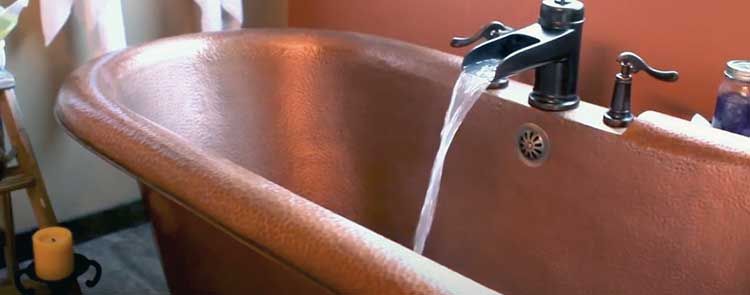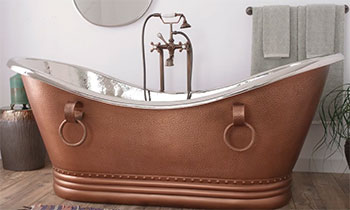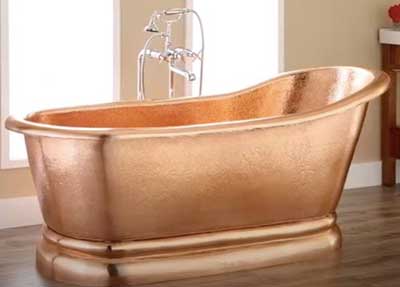Not everyone is up for a copper bathtub. Though like every other bathtub type, the copper bathtub has both pros and cons.
But mainly I will talk about problems with copper bathtubs and how serious are those issues. And lastly, whether those bathtubs are worth it or not.
Stay with me for a while.
Common Copper Bathtub Drawbacks

Let’s talk about some of those disadvantages and see whether such tubs are worth it or not:
- Difficult Installation of Copper Bathtubs
One of the biggest headaches with installing a copper tub is the sheer weight of the material. A 60” tub can weigh 350-600 pounds! This makes moving and situating the tub extremely difficult.
Most homes require bringing the tub through a window opening via crane onto the second floor for installation. Even moving the tub across finished floors can cause damage. Installers strongly advise installing a copper tub before final flooring is complete.
Once in place, the tub must be perfectly leveled on all sides, which takes time and precision. The drain and overflow connections also require expertise so leaks are prevented.
The complexity means professional installation is a must for copper tubs, which adds $2000 or more to costs. The headache of installation is the first major downside to consider.
- Highly Expensive
It’s costly and not within everyone’s budget. Since such bathtubs are made from pure copper and copper are pricey material, it has to be expensive.
Besides, precise construction is important, and making copper bathtubs require expert craftsmanship and more labor work. Due to limited brands, you will have to pay for shipping and handling charges as well.
And all those factors lead to a higher cost.
- Scratching Issue
Anything made from copper is highly susceptible to scratches. Copper bathtubs are no exception. If you have kids, you will face the problem a lot!
So, having a scratched bathtub is a big downside and a big concern for many people. And once scratched, it’s not worth repairing either.
Because once the scratches show up, they will never stop no matter how rigorous repairing you do.
- May Dent Over Time
Apart from scratches, it is subject to dents and dings too. A dented tub is an eyesore. Anything made from a thin metal is subject to dents and dings.
That’s why noticing the ‘gauge’ of the metal is important. It indicates how many times it has been recycled and gone through rollers to thin it. The lower the gauge the better the quality.
Any tubs made from pure copper with 14 to 16 gauge are good and are highly unlikely to be dented over time. You should avoid tubs with any gauge thinner than 16.
- Scarcity
Well, even if you love to have one, it will be hard to find one most likely. Not many brands are delivering copper baths and they sell them to some selected stores.
So, there is a higher chance it won’t be available to your nearby home improvement store. You need to order it from some very specific manufacturers. Most probably from online.
Since there are limited manufacturers, you will have limited options as well in terms of design, size, and pricing.
- Risk of Having Blacken Soldered Seams
There are two types of seams when it comes to copper bathtubs: soldered and welded. Copper bathtubs from top brands come with welded seams and you have nothing to worry about in this regard.
However, copper tubs from cheap brands may come with soldered seams. Soldered seams are very weaker among the two and blacken over time. It becomes very unsightly then.
For soldered seams, manufacturers use different metals instead of copper to join metals. That becomes a big inconsistency issue as well.
- Risk of Discoloration
Another concern is corrosion of the tub’s appearance when you use bath salts or Epsom. You will have to let go of bath salts or Epsom if you have a copper bathtub.
- Limited Size and Shape Options With Copper Tubs
For homeowners with a vision of an intricately shaped soaking tub or larger sizes, copper may not accommodate. The malleable copper material limits most tubs to simple oval, rectangular, or classic clawfoot shapes in smaller dimensions.

Here are the typical size constraints:
- Length – 48 to 66 inches maximum
- Width – 28 to 42 inches maximum
- Depth – 14 to 24 inches maximum
- Weight capacity – 100 to 200 lbs maximum
Custom sizes or shapes outside the norm get exponentially more expensive. So creativity is restricted compared to fiberglass, acrylic, or porcelain tubs. For larger bathers or those desiring an expansive tub, copper may not provide the ideal fit.
- Copper Retains Heat – Risk of Water Getting Too Hot
One quirk of pure copper is that it conducts and retains heat very efficiently. This means hot bath water can get uncomfortably or even dangerously hot compared to other tub materials.
Kids, seniors, or those with sensitivities should exercise caution with very hot water, as the copper tub will not allow heat to dissipate as quickly. Starting with a lower temperature is wise to prevent scalding.
If heated towel racks, hot tub fillers, or other heat sources are added, the tub’s water can creep up in temperature if not carefully monitored. Just be aware the tub material itself won’t passively cool things down.
- No Built-In Overflow Drain in Copper Tubs
Today most standard tubs come with an overflow drain built into the design. This provides a necessary secondary drain to prevent accidental overfilling. But copper tubs typically lack integrated overflow drains.
This means a plumber must modify and add an overflow separately. The connections must be water-tight to prevent leakage behind walls or underflooring. If the overflow is not properly installed, it could lead to costly water damage.
Some minimalist designs purposefully omit the overflow. But exercise caution, as no overflow leaves zero margin for error when filling the tub. Unless carefully planned, adding an overflow is highly recommended.
- Copper Tubs Require Weekly Cleaning and Monthly Polishing
To keep a copper tub looking its best, expect to put in consistent maintenance work on at least a weekly basis. Quick cleanings after each use prevents buildup of residue. But a thorough cleaning session weekly is ideal to break down soaps, body oils, and mineral deposits.
Monthly polishing is also advised to maintain the tub’s shine and luster. This involves using abrasive pastes and buffing out oxidation and discoloration. Doing this by hand takes 30-60 minutes per month. Neglecting it allows patina to build up.
Infrequent users may get by with biweekly or monthly cleanings. But copper’s beauty comes at the cost of dedicating routine time to care and upkeep. Hiring a professional cleaning service is also an option, at additional expense.
- Not Every Tub Is Made of Pure Copper
Yes, there is no scarcity of pure copper but not every copper product is made of pure copper. A lot of them are made from recycled resources.
Sometimes, manufacturers add brass or alloys with copper to make copper products. A tub made from such mixed material won’t have all the beneficial factors of pure copper.
Sadly, it’s hard to tell the difference. So, you should ask the manufacturer or dealer if you want 100%, pure copper.
Are Copper Bathtubs Worth It?

For centuries, people are familiar with the benefits of copper. It has antibacterial properties and no other bathroom types have the same qualities.
Because of that properties, it can kill almost 99% of bacteria within just 2 hours whereas bathtubs made from other materials like fiberglass will allow the bacterial to live for months.
So, the surface of your copper tub will never be living spots of any bacteria known to humans. You and your family will be safer.
It will never corrode or rust over time. It requires minimum maintenance and cleaning. It will require a whole new article to write about all the benefits of the copper tub.
Another great feature is that it ages like a fine wine. When the copper interacts with the environment, the color will deepen over time and the ultimate finish will look awesome.
I truly recommend a copper bathtub if it’s made from pure copper. Such tubs last for generations. If you can afford the cost, you should have one.
Frequently Asked Questions (FAQs)
If it’s made from pure copper, it’s not bad for you since they don’t contain lead or mercury. However, cheap copper tubs that are made from recycled copper contain harmful materials.
No, you can’t use Epsom salts in your copper tub. Any of such bath salts will tarnish and corrode the appearance of your copper tub.
Copper baths tarnish in their raw unfinished state. But what you have in the bathroom is a finished one. It will tarnish if you use any bath salts only.
Yes, copper bathtubs are comfortable and relaxing. The timeless appearance alone will add royal value to your bathroom.
Yes, you can and the tub will hold the heat for a longer time. Don’t worry. The coated finish will act as a safeguard against any sort of damages.
Contrary to popular believe, copper tubs are not cold at all. It will be as cold as the water poured into it.
Closing Remarks
It may seem to you that there are lots of drawbacks to copper bathtubs. I did not mention all the benefits of having a copper tub but rest assured, it’s priceless and timeless.
All you have to do is ensure you are getting it from a trusted manufacturer. Any copper tub made from pure copper is good for your body and it adds extra elegance to your bathroom.
